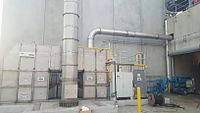
Photo from wikipedia
Abstract Dry granulation process is one of the most promising methods for waste heat utilizing from molten slag. The net heat recovery efficiency and recycling costs of slag particles are… Click to show full abstract
Abstract Dry granulation process is one of the most promising methods for waste heat utilizing from molten slag. The net heat recovery efficiency and recycling costs of slag particles are mainly governed by the granulating characteristic. This paper performed a high-temperature analogy experiment by rotating disk with molten aluminum as the medium. The results indicated that the mean size of particles grew with the increasing of feed rate and cooling air rate, decreasing in rotating speed. The cooling air rate showed a little effect on the size distribution of the main particles, while lowered the production yield. The circularity shape factor of particles was mainly influenced by the rotating speed, cooling air rate and the oxide film formed on the particle surface. The liquid film breakup mode and cooling rate of particles played significant roles in the formation of filaments. In the fully-ligament mode, lower mass fraction of filaments was generated, while the filaments increased rapidly once the liquid film broke up by sheet mode. It was suggested in the granulation of blast furnace slag that, the particle characteristics should directly be governed by rotating speed, and the cooling air rate must be controlled strictly.
Journal Title: Applied Thermal Engineering
Year Published: 2017
Link to full text (if available)
Share on Social Media: Sign Up to like & get
recommendations!